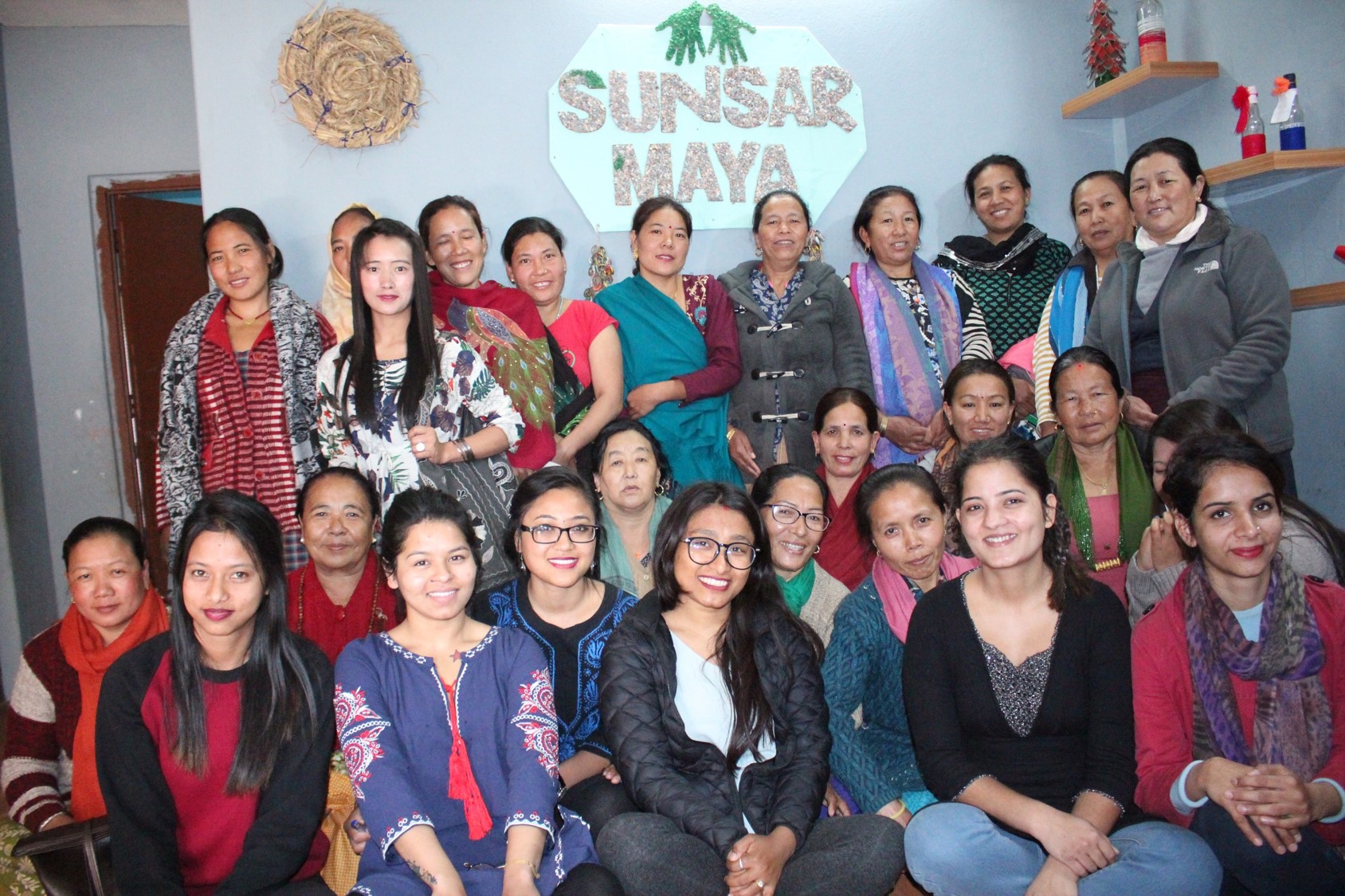
Mission
Sunsar Maya builds pathways out of poverty by improving the livelihoods of vulnerable women and children through holistic, community-based services.
Life Challenges of the Women Served
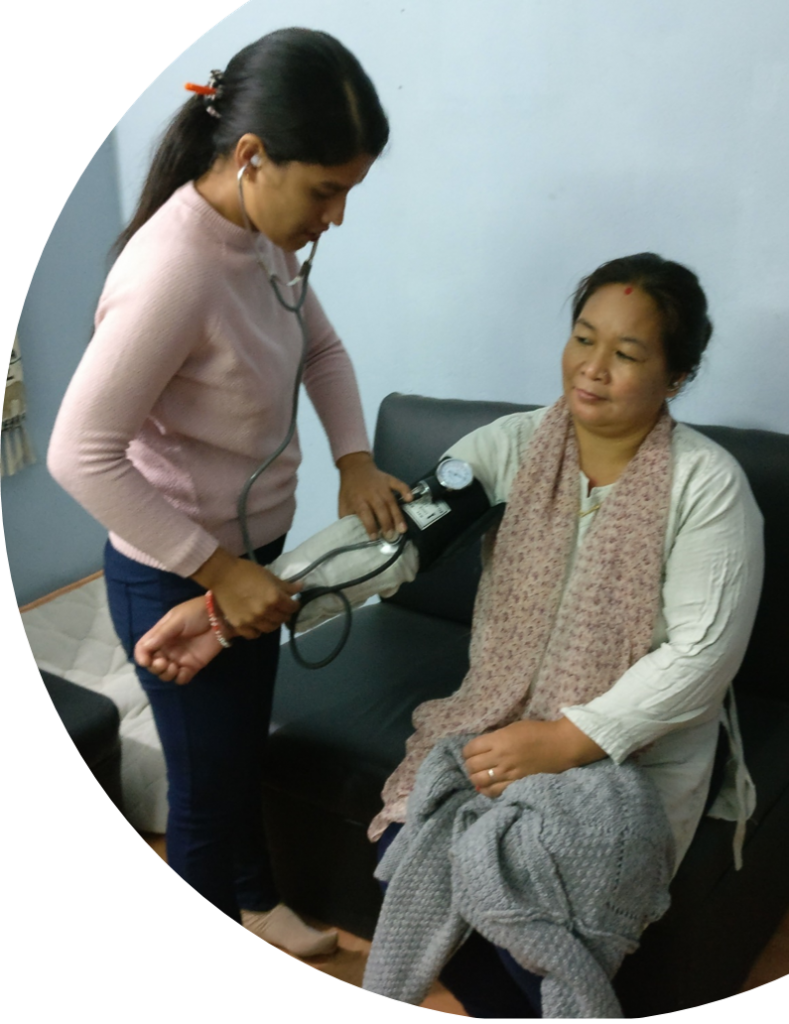 Illiteracy traps Nepali women in an endless cycle of dependence on husbands and family members, limits their life expectancy, and leads to intergenerational poverty. Illiteracy also hinders access to medical care and other services, and increases the likelihood of domestic abuse, substance abuse, chronic stress, and mental health issues. For women who are both illiterate and unable to speak the national language (Nepali), the situation is even more dire as they experience increased barriers for navigating daily life outside the home.
Illiteracy traps Nepali women in an endless cycle of dependence on husbands and family members, limits their life expectancy, and leads to intergenerational poverty. Illiteracy also hinders access to medical care and other services, and increases the likelihood of domestic abuse, substance abuse, chronic stress, and mental health issues. For women who are both illiterate and unable to speak the national language (Nepali), the situation is even more dire as they experience increased barriers for navigating daily life outside the home.
There are many reasons why women are particularly vulnerable in Nepali society, including:
- High dropout rates: In Nepal, 40 percent of students drop out before completing primary school and half of Nepali women are illiterate. Dropout rates are exacerbated by early marriage and pregnancy, lack of accessibility, affordability, the quality of education, and the relevance of instruction to students’ day-to-day lives. Women lack equal access to education and as a result, have few economic opportunities. The lack of easy and affordable access to sanitary supplies is another ongoing problem for girls, which impacts their school attendance. The chhaupadi practice (in which girls and women are exiled to menstrual huts) although illegal, still occurs, impacting their schooling and participation in economic and social activities.
- High poverty and income inequality: Nepal is one of the world’s poorest countries. Following years of political and civil unrest, 60 percent (17 million people) live on $2 a day or less. The combination of widespread poverty, high illiteracy rates, and unplanned pregnancies has led to increasing numbers of women and children living in extreme poverty, creating a cycle of low levels of schooling and fewer opportunities for economic empowerment. High levels of domestic abuse compound vulnerabilities and push women and girls into the drug trade, being sold as indentured servants, or into the commercial sex trade. An estimated 10,000 women and girls are trafficked from Nepal to India every year.
- Early marriage and pregnancy: About 40 percent of girls are married before age 18, which forces them to terminate their education in order to care for husbands and families.
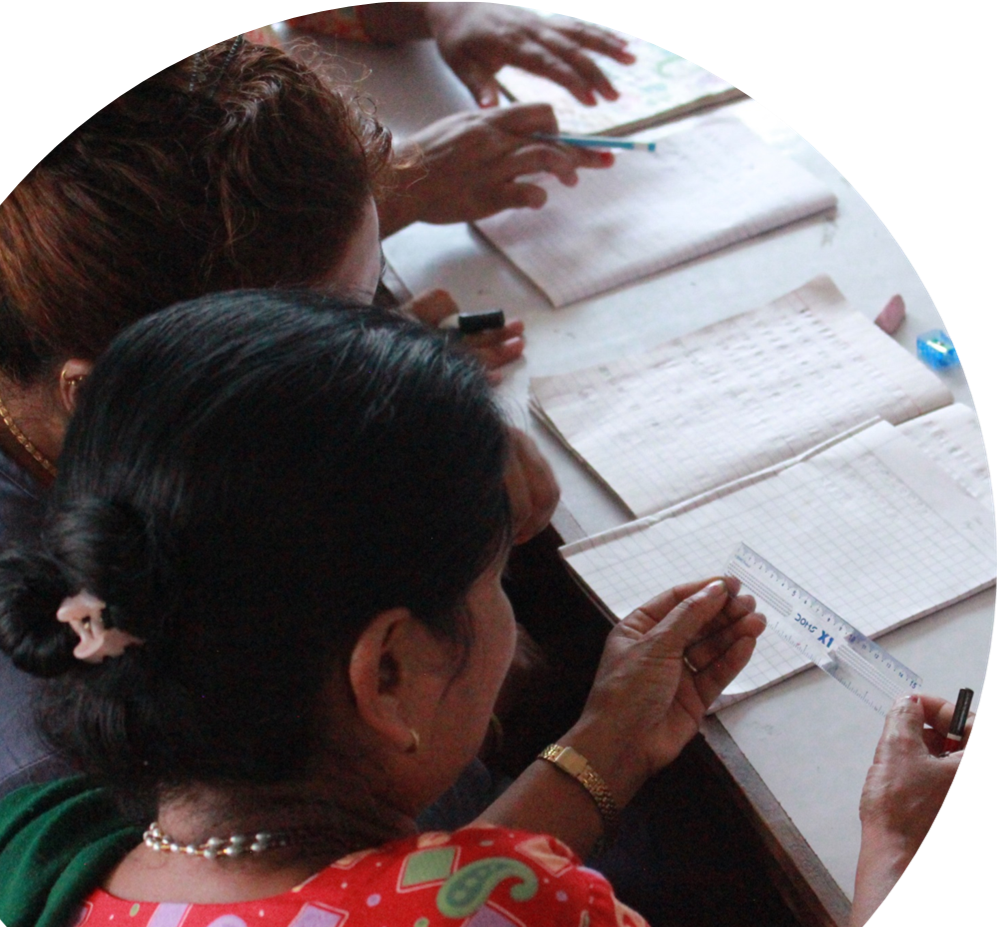
- Cultural barriers/caste system: In spite of tremendous progress in recent decades, traditional cultural practices and beliefs see investing in girls and women as a waste, as women are believed to be best suited for taking care of a household and family. In addition, the longstanding effects of the Nepali caste system continue to limit opportunities for those considered born into the lower levels of the system, while individuals born into the higher levels tend to have access to, and thus succeed in, education, government, and high-paying jobs.
- The effects of COVID-19: Travel and tourism are among the largest industries in Nepal, supporting more than 420,000 jobs each year. However, tourism has been hit dramatically by COVID-19. Demand has declined, leaving many families struggling to get by. In addition, access to education has decreased significantly, as few poor families have the means to access remote learning resources. The pandemic has also negatively affected the provision of obstetric and gynecological health services, making it even more difficult for women to have their essential sexual and reproductive health care needs met. In addition, women and girls confined to their homes are at increased risk of domestic violence, and there is evidence that child marriages are increasing as the COVID-19 crisis continues. Many children – especially girls – are vulnerable in this environment, as they may be forced to abandon their education to help financially support their families.
- Gender-based violence (GBV): GBV has been on the rise in Nepal. A report by the United Nations Population Fund suggests that 48 percent of women in Nepal have experienced violence at some point in their lives, with 27 percent experiencing physical violence. The pandemic has only worsened gender violence in Nepal. According to a study published in the Kathmandu Times, “Every 10 minutes, a woman somewhere in Nepal dials 1145, the helpline operated by the National Women Commission (NWC), seeking assistance.”
The Project
Sunsar Maya’s (SuMa) Women’s Literacy project gives women in Mahalaxmi and Jorpati, Nepal, the tools to rise out of poverty. This program improves women’s income-earning potential, political participation, community involvement, and reproductive and overall health. It also leads to increased self-esteem and confidence and better outcomes for the women’s children. Literacy provides women an opportunity to exercise control over their lives, to find and access the help they need, and the ability to make their voices heard in their families and communities. Women without these skills, especially those who only speak their regional language, are unlikely to find meaningful work and are almost entirely reliant on their husbands and families. Becoming independent, self-sufficient, and able to exercise agency over your own life is nearly impossible without basic literacy skills.
This project is symbolic of the holistic approach SuMa takes to education, ensuring that each student has opportunities for happy, healthy, and empowering access to educational opportunities. The SuMa Women’s Literacy project consists of three components: 1. classes to gain literacy and numeracy skills, 2. workshops to gain business and healthcare knowledge, and 3. women’s councils to build women’s leadership skills and to identify and help solve the most pressing challenges the women face. Students receive bi-annual medical checkups and health-related counseling, such as reproductive health and domestic violence prevention.
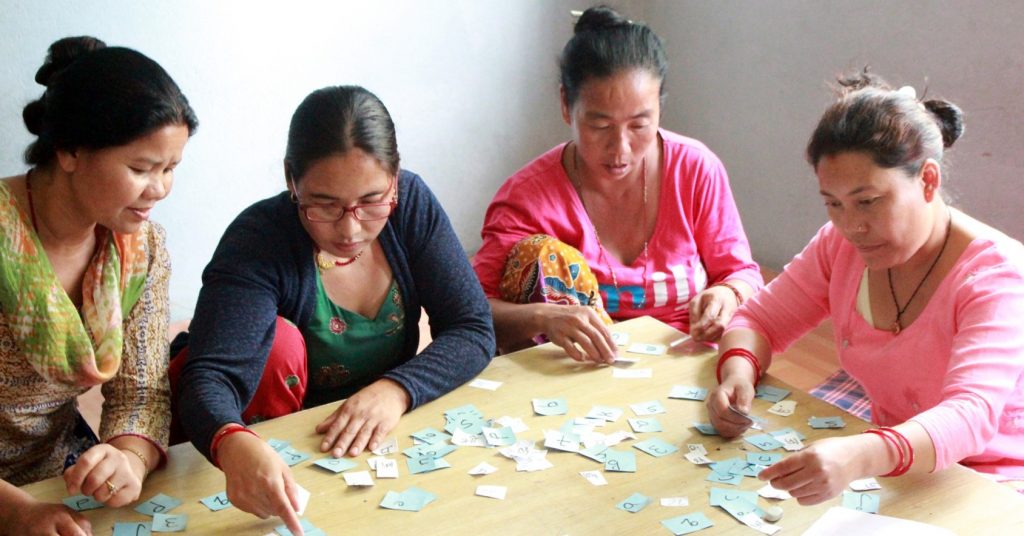
Literacy/numeracy classes for 100 women: Instruction is provided in four core areas: conversational and written English, Nepali, and mathematics. English skills enable participants to use communication devices like cell phones and computers, which use English characters. By building participants’ literacy and numeracy skills in Nepali, they are able to manage daily tasks more easily –like shopping and paying bills – participate more fully in their communities and the political process, and access healthcare and other services. SuMa uses tangible and meaningful life experiences rather than rote memorization. For instance, literacy lessons are taught by navigating government offices or performing Google searches, and math is taught by balancing a bank account and calculating discounts and sales tax at markets on mobile phones.
Monthly workshops for 640 women: The workshops are comprised of alternating instruction in two major themes: 1. small business and entrepreneur skills (opening and operating a small business, marketing, accounting, taxes, etc.) and health (women’s health, mental health, domestic abuse, etc.) and 2. family matters (early childhood development, healthy parenting skills, etc.). Both project participants 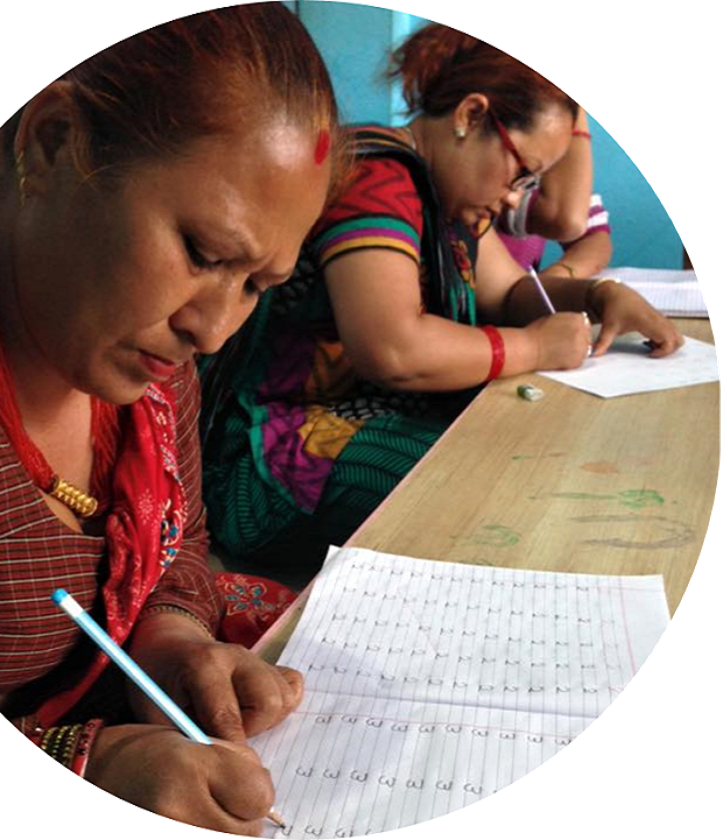 and the greater community are invited to attend, and workshops are typically offered on Saturdays to allow for the greatest number of attendees. As often as possible, workshops are led by community-based leaders in their fields. Workshops address a range of issues that are typically inaccessible to these women.
and the greater community are invited to attend, and workshops are typically offered on Saturdays to allow for the greatest number of attendees. As often as possible, workshops are led by community-based leaders in their fields. Workshops address a range of issues that are typically inaccessible to these women.
Women’s councils for 14 women: Two seven-member councils meet monthly, comprised of teachers, students, and women in the community. The goal of these councils is to create a closer connection to the community, build women’s leadership skills, and provide a forum for the women to identify the most pressing challenges and develop creative solutions to those problems. For instance, during their initial meetings in the fall of 2020, both councils identified domestic abuse as the most pressing challenge, and the councils will work with members of their communities to identify solutions to this growing problem. The first group of SuMa Women’s Council members were identified and invited to participate by Sunsar Maya staff. As the program matures the councils may decide to implement a more formalized selection process and may expand the number of participants. To support the councils, SuMa works with community partners, including Nepal Orphans Home (NOH).
(Over 2 years) 740 direct beneficiaries and 3,655 indirect beneficiaries (family members)
UN Sustainable Development Goals
![]()
![]()
![]()
![]()
![]()
Questions for Discussion
How do you think gaining literacy skills affect all areas of a person’s life?
How does this project promote gender equality?
What is the benefit of inviting the broader community to the workshops?
How the Grant Will be Used
Together Women Rise’s grant of $25,000 over two years will help fund the following:
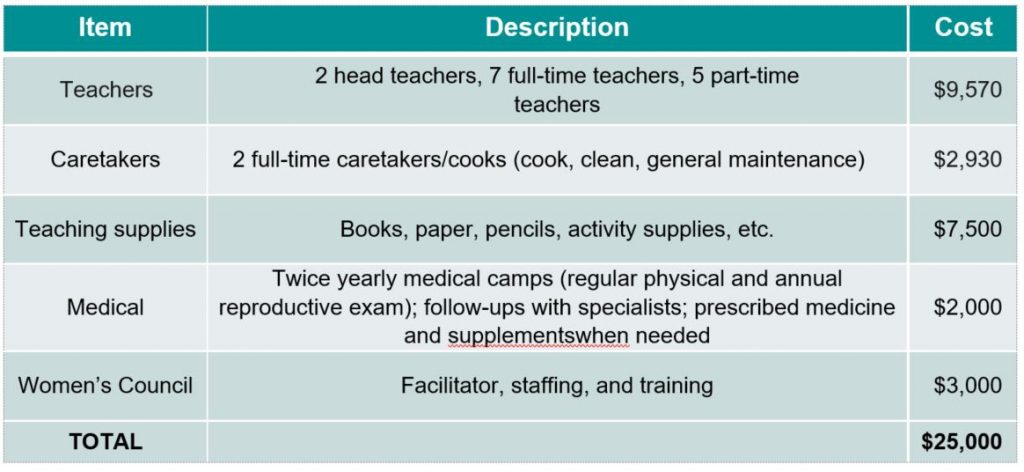
Why We Love This Project/Organization
The women and girls in the Sunsar Maya community face challenges such as high dropout rates, high poverty and income inequality, cultural and caste barriers, early marriage, and pregnancy. The project teaches women conversational and written English, Nepali, mathematics, and life skills. By using role play and experiential learning, this project provides women with the education and support they need to transform their lives and build pathways out of poverty.
Evidence of Success
To assess student progress and program impact, SuMa administers yearly evaluations, utilizing test scores, teacher assessments, and self-evaluations. The outcomes are impressive.
In 2017-2018
- 92 women participated in SuMa’s Women’s Literacy programs.
- 77 percent were promoted to the next level of instruction.
- 95 percent reported a positive sense of self
- 97 percent reported having a more positive outlook on life.
- 96 percent reported a greater ability to learn and succeed.
- 100 percent had access to bi-annual medical care; they also received cervical cancer screenings through SuMa’s partnership with the Family Planning Association of Nepal.
- 100 percent had access to workshops presented in partnership with other organizations.
In 2018-2019: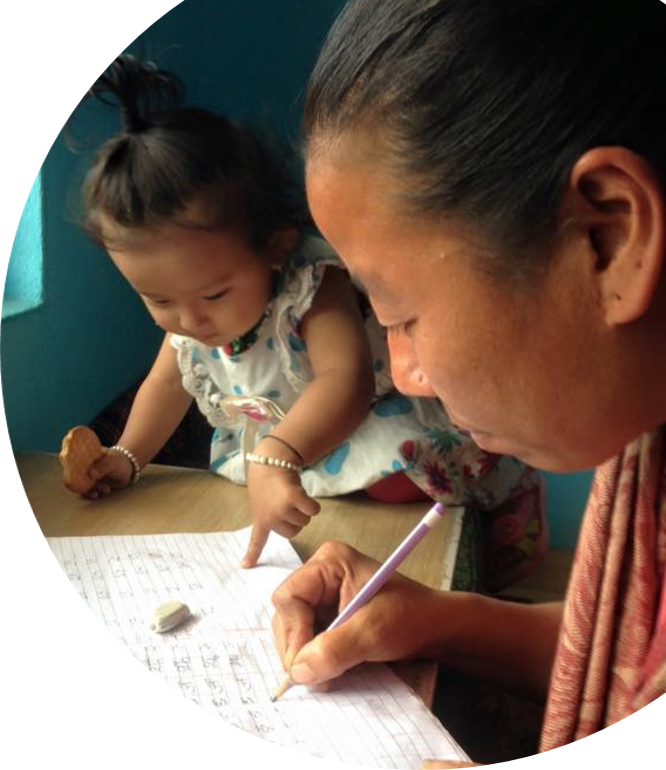
- 90 women participated in SuMa’s Women’s Literacy programs.
- 75 percent were promoted to the next level of instruction.
- 97 percent reported a better sense of self.
- 99 percent reported having a more positive outlook on life.
- 95 percent reported a greater ability to learn and succeed.
- 100 percent had access to bi-annual medical care.
- 100 percent had access to workshops presented in partnership with other organizations.
In 2019-2020:
- 94 women participated in SuMa’s Women’s Literacy programs.
- 92 percent reported a better sense of self.
- 94 percent reported having a more positive outlook on life.
- 91 percent reported a greater ability to learn and succeed.
- 100 percent had access to bi-annual medical care.
Voices of the Girls
“I once was so embarrassed at the hospital because I couldn’t even go to the room assigned for [my] checkup as I couldn’t read at all. And there have been many cases when I used to be cheated by shopkeepers and vendors as I couldn’t calculate. After being part of the program for a year, I can easily read and write simple words in both English and Nepali, I can do calculations like add, subtract, and even can find out profit and loss. I am sure that I won’t be embarrassed anymore because of being illiterate.”
“I have come a long way since I joined the program. I always feared interacting with new people as I couldn’t speak Nepali that well, as my native tongue is Newari. I always felt shy and uncomfortable talking with new people. After being part of the SuMa program and learning in very homely environment with sister-like teachers, I have overcome my limitations. I have learned Nepali and to my surprise have learned English as well. The most rejoicing moment for me recently has been participating in a public speaking workshop where I gave a short speech. My journey from a shy woman bound in the four walls of my house to a woman participating in a public speaking workshop has been possible only because of Sunsar Maya and its teachers.”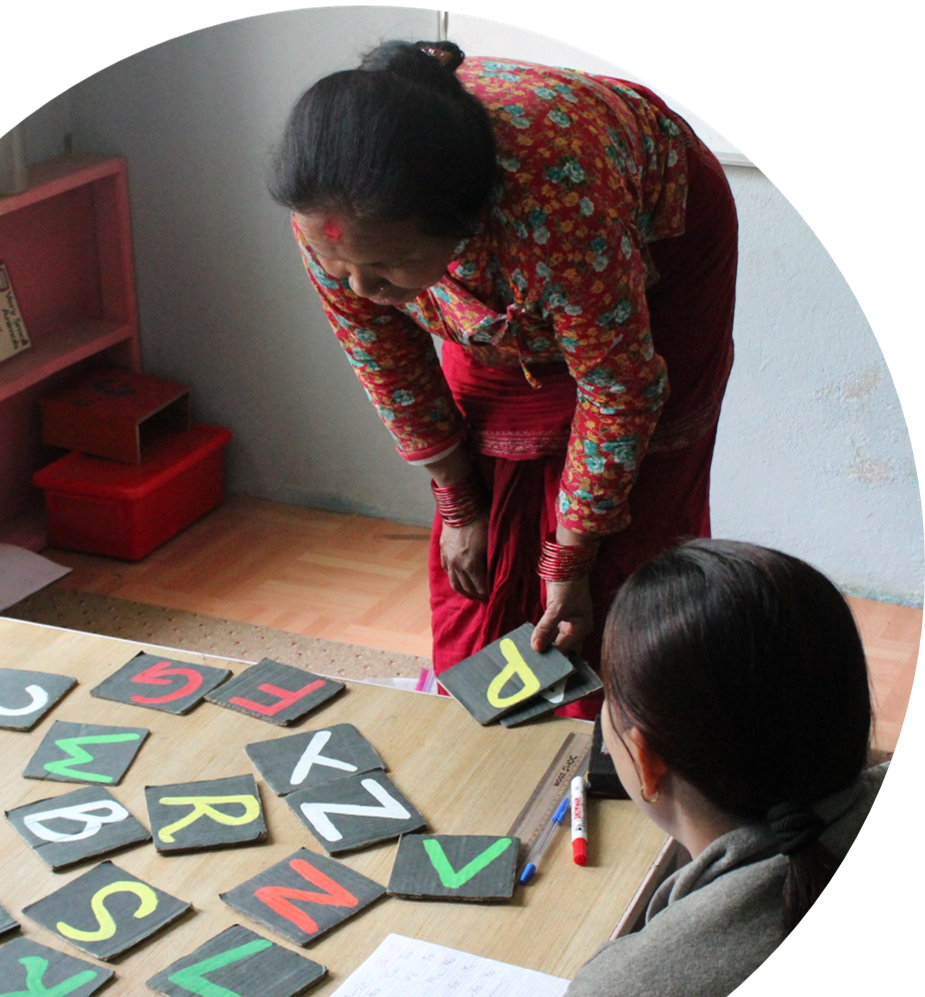
“I never [worked] in our family shop as a shopkeeper, as I couldn’t identify the goods by name and I can’t do transactions with customers, even simple addition and subtraction. It has been two years since I have been part of the Sunsar Maya Women Literacy Program and I am looking after the shop confidently in recent days. Thanks to the Sunsar Maya teachers who have persisted with me and teaching me the basic mathematics, Nepali and English, which has really helped me.”
“I can now understand what people say in English and respond back to many questions. The additional virtual class [during lockdown] has been a boon to me. I can now video chat, use both languages for texting and can use various digital features without help of my daughter. In fact, I invest more time in learning.”
About the Organization
Based in Nepal, Sunsar Maya builds pathways out of poverty by improving the livelihoods of vulnerable women and children through holistic, community-based services. Sunsar Maya was co-founded in 2011 by Executive Director Jehán Seirafi, board member Ginger Colton, James Kearns, and Santiago Diab.
SuMa serves women of all ages, with the average age between 30 and 60 in the communities of Jorpati and Mahalaxmi. These women have little or no formal education. Only a handful are working within the formal economy – most rely on their husbands, families, or broader community for support. None of the women have access to regular health checkups outside those offered by SuMa’s programs.
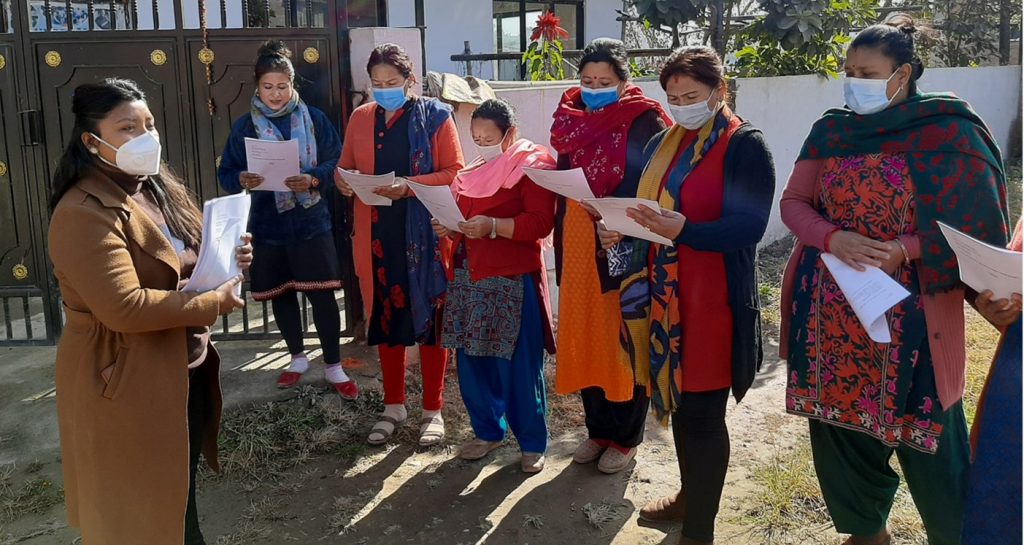
Other the years, SuMa has grown and provided an increasing number of critical services, including:
SuMa’s after school program provides children ages 3 – 17 living in orphanages and/or extreme poverty with holistic services that include progressive education, medical and mental health care, and nutritional support in a caring and safe environment.
SuMa Women’s Literacy Program: To further support the community of Jorpati, SuMa piloted the first SuMa Women’s Literacy program in 2016 to address Nepal’s low adult literacy rate. The goal was to educate and empower women in the community, some of whom were mothers or caregivers of children enrolled in SuMa’s after school program. During the pandemic, SuMa shifted to providing virtual literacy and numeracy instruction, which was supplemented with at-home learning kits that included supplies and practice books/worksheets.
Community workshops: In 2019, to expand opportunities for women beyond the literacy and numeracy classes, SuMa began offering educational workshops to support students’ autonomy through enhanced life skills and skills-based learning.
Women’s Councils: In 2020, SuMa formed the Women’s Councils to increase leadership opportunities and to provide women in the community a platform for creating community-wide change.
SuMa Teacher Training: Launched in 2018, SuMa’s teacher training program helps teachers in rural Nepal develop progressive educational methods through training in experiential and project-based learning in STEAM (Science, Technology, Engineering, Arts and Math) concepts.
Emergency Aid: SuMa has also provided emergency aid to their communities during disaster situations like the 2015 earthquakes and, more recently, the ongoing COVID-19 pandemic.
Videos:
Sunsar Maya feature on Janata TV, Nepal
Sunsar Maya women’s literacy overview (Pre-COVID-19)
Students learning in a virtual environment
Where They Work
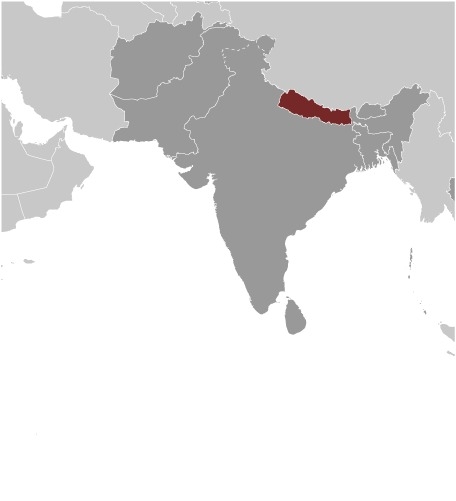

Nepal is a landlocked, mountainous country between China and India that’s about the size of New York. It is among the least developed and poorest countries in the world, with one out of four people living below the poverty line and one out of four children under age 5 underweight. Two-thirds work in agriculture. Nepal’s economy is challenged by its landlocked location, inconsistent electricity, underdeveloped transportation system, and frequent political changes that range from a monarchy to Communism. The 2015 earthquake and COVID-19 crisis have worsened the economic situation. As many as 4 million Nepalese migrant workers endure harsh working conditions in India, Qatar, Malaysia, Saudi Arabia, and the United Arab Emirates.
The population of 30 million Nepalese consists of many ethnicities, with Chhettri (17 percent) and Brahman (12 percent) comprising the largest groups. The official language is Nepali, yet it is only spoken by 45 percent of the population. There are numerous regional languages, including Maithali, Bhojpuri, Tharu, Tamang, and many others. Nepal has the highest percentage of Hindus (81 percent) of any country in the world. Seventy-nine percent of men are literate, but only 59 percent of women.
Nepal is home to eight of the world’s 10 highest peaks, including the highest point on Earth, Mount Everest, at 29,000 feet. It is also the source of the Ganges river. Summers are cool and winter is harsh in the north, while in the south summer is subtropical and winter is mild. Natural disasters plague Nepal, including monsoons, floods, landslides, and drought.
Sunsar Maya works in Jorpati, Kathmandu and Mahalaxmi, Lalitpur.
A closer look at the role of mobile phones and digital technology for women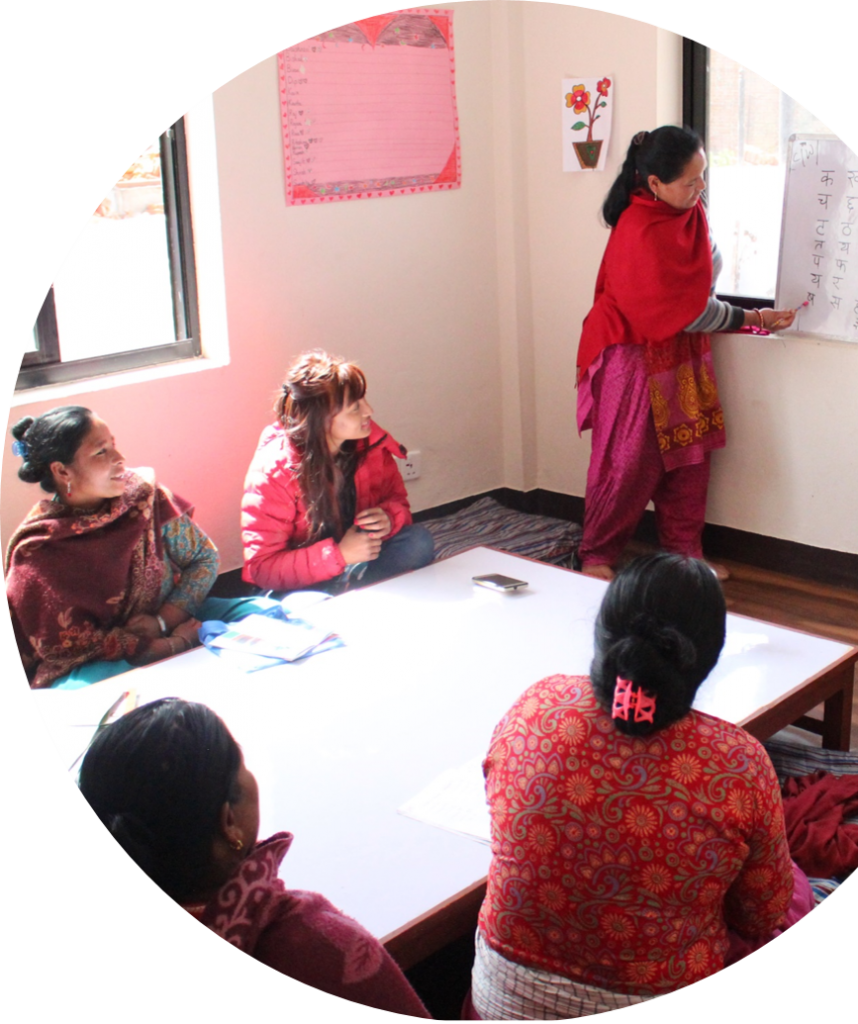
We consider our cell phones a convenience, but for many women around the world they are much more than that. For women in low income countries, owning a mobile phone can mean greater gender equality, financial (and personal) independence, more employment opportunities, better health, contraceptive use, improved education, and access to government services. In particular, opening a mobile bank account allows women control over their money or even the ability to start a business. It also allows women – even those living in remote villages – to make healthcare appointments and register their children for school.
Unfortunately, there are 1.7 billion women in low income countries who do not own a mobile phone. Some of these women are simply denied mobile phone ownership, especially if owning one means working with a male mobile agent. Women in South Asia are particularly disadvantaged, as they are 38 percent less likely than men to own a mobile phone. To bridge this gap, many cultural, social, and legal barriers must be broken.
Mobile phones and other digital technologies and devices (tablets, etc.) also improve a woman’s chance of gaining an education. For this to occur, women need open and affordable access to the internet, a powerful tool and motivator that ultimately broadens a woman’s learning and economic opportunities. For girls, internet access can complement traditional classroom learning both in quality and in the subjects covered.
The COVID-19 pandemic and resulting lockdowns and school closures have taught communities across the world the importance of digital technology and the investments that need to be made in online learning and digital commerce.
Source Materials
https://www.ox.ac.uk/news/2020-06-08-mobile-phones-empower-women-developing-world-oxford-study
https://a4ai.org/leaving-no-learner-behind-closing-the-digital-divide-in-africa-is-more-important-than-ever/
https://theirworld.org/news/mobile-phones-help-empower-educate-african-women
https://www.brookings.edu/blog/future-development/2019/04/10/mobile-phones-are-key-to-economic-development-are-women-missing-out/
https://www.cia.gov/the-world-factbook/countries/nepal/
https://www.nationsonline.org/oneworld/nepal.htm
